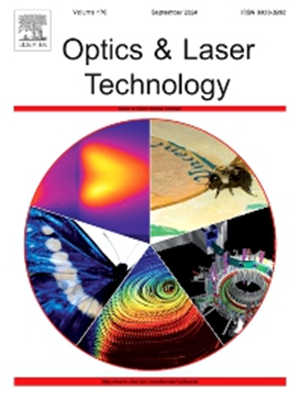通过水下湿激光熔覆探索激光诱导保护材料辅助提高多道 ER2209 涂层的成型质量
IF 4.6
2区 物理与天体物理
Q1 OPTICS
引用次数: 0
摘要
水下湿激光熔覆(UWLC)技术在海洋工程设备的原位修复方面具有相当大的应用潜力。此外,多通道 UWLC 具有显著的实际应用价值,可确保水下维修处理的效率。在复杂的水下环境中形成的具有高成型质量的多通道激光熔覆层具有显著的应用价值。本文报告了原位多通道 UWLC 双相不锈钢(DSS)涂层制备的新成果。在完全潮湿的环境中成功制备了多层 ER2209 UWLC 涂层。采用激光诱导的自我保护材料来抵消和消除水环境对 UWLC 涂层成型质量的影响。结果表明,包覆层表面的大量气孔缺陷是由激光诱导空化和水电离等效应造成的。有效使用激光诱导保护材料可减轻水侵入的不利影响。水下多通道激光器输入的热量和保护材料的放热作用抵消了水下环境的快速冷却效应。与 ER2209 空气激光熔覆(ALC)涂层相比,晶界位错的积累会略微降低 ER2209 UWLC 涂层的耐腐蚀性。在激光诱导保护材料的辅助下形成的多通道水下熔覆层为水下设备的原位修复提供了宝贵的理论依据。本文章由计算机程序翻译,如有差异,请以英文原文为准。
Exploring laser-induced protection material assisted elevating the forming quality of multi-pass ER2209 coating via underwater wet laser cladding
Underwater wet laser cladding (UWLC) technology has considerable application potential for in situ repair of offshore engineering equipment. Moreover, multipass UWLC has notable practical application value and can ensure the efficiency of underwater repair processing. A multipass laser cladding layer with high forming quality that is formed in a complex underwater environment has notable application value. Herein, new results regarding the preparation of in situ multipass UWLC duplex stainless steel (DSS) coatings are reported. Multipass ER2209 UWLC coatings are successfully prepared in a completely wet environment. Laser-induced self-protection materials are used to counter and eliminate the effects of the water environment on the forming quality of the UWLC coatings. The results show that the numerous porosity defects on the cladding layer surface are attributed to effects such as laser-induced cavitation and water ionization. Effective use of laser-induced protective materials mitigates the detrimental effects of water intrusion. The rapid cooling effect of the underwater environment is counteracted by the heat input form the underwater multipass laser and the exothermic action of the protective material. Compared with ER2209 air laser cladding (ALC) coatings, the accumulation of dislocations at grain boundary slightly decreases the corrosion resistance of the ER2209 UWLC coatings. Multipass underwater cladding formation assisted by laser-induced protection materials offers valuable theoretical insights for in situ repair of underwater equipment.
求助全文
通过发布文献求助,成功后即可免费获取论文全文。
去求助
来源期刊
CiteScore
8.50
自引率
10.00%
发文量
1060
审稿时长
3.4 months
期刊介绍:
Optics & Laser Technology aims to provide a vehicle for the publication of a broad range of high quality research and review papers in those fields of scientific and engineering research appertaining to the development and application of the technology of optics and lasers. Papers describing original work in these areas are submitted to rigorous refereeing prior to acceptance for publication.
The scope of Optics & Laser Technology encompasses, but is not restricted to, the following areas:
•development in all types of lasers
•developments in optoelectronic devices and photonics
•developments in new photonics and optical concepts
•developments in conventional optics, optical instruments and components
•techniques of optical metrology, including interferometry and optical fibre sensors
•LIDAR and other non-contact optical measurement techniques, including optical methods in heat and fluid flow
•applications of lasers to materials processing, optical NDT display (including holography) and optical communication
•research and development in the field of laser safety including studies of hazards resulting from the applications of lasers (laser safety, hazards of laser fume)
•developments in optical computing and optical information processing
•developments in new optical materials
•developments in new optical characterization methods and techniques
•developments in quantum optics
•developments in light assisted micro and nanofabrication methods and techniques
•developments in nanophotonics and biophotonics
•developments in imaging processing and systems

 求助内容:
求助内容: 应助结果提醒方式:
应助结果提醒方式:


